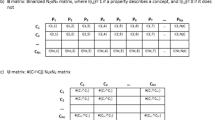Abstract
The motivation for undertaking the research on relations, such as complementarity, is complexity of real-world phenomena. Authors aim at preparation of proper modeling tools that would enable to describe dependencies to the greatest extent. The objective of this article is to discuss relation of complementarity. Authors propose definition of complementarity for concepts described with features. Concepts represent phenomena, features describe concepts. The paper is oriented on research on similarity. Authors propose similarity relations for complementary structures in spaces of features and concepts.
Access this chapter
Tax calculation will be finalised at checkout
Purchases are for personal use only
Similar content being viewed by others
References
Belanche, L., Orozco, J.: Things to know about a (dis)similarity measure. In: König, A., Dengel, A., Hinkelmann, K., Kise, K., Howlett, R.J., Jain, L.C. (eds.) Knowledge-Based and Intelligent Information and Engineering Systems. Lecture Notes in Computer Science, vol. 6881, pp. 100–109. Springer, Berlin (2011)
Box, G.E.P., Draper, N.R.: Empirical Model-Building and Response Surfaces. Wiley, New York (1987)
Goshtasby, A.A.: In: Singh, S., Kang, S.B. (eds.) Image Registration: Principles, Tools and Methods. Advances in Computer Vision and Pattern Recognition, pp. 7–66. Springer, London (2012)
Homenda, W.: Balanced fuzzy sets. Inf. Sci. 176(17), 2467–2506 (2006)
Homenda, W., Jastrzebska, A.: Complementarity and similarity of complementary structures in spaces of features and concepts. In: Skulimowski, A.M.J. (ed.) 8th International Conference on Knowledge, Information and Creativity Support Systems, pp. 149–160. Progress & Business Publishers (2013)
Hung, W., Yang, M.: Similarity measures between type-2 fuzzy sets. Int. J. Uncertain. 12(6), 827–841 (2004)
Hung, W., Yang, M.: Similarity measures of intuitionistic fuzzy sets based on Hausdorff distance. Pattern Recognit. Lett. 25, 1603–1611 (2004)
Jastrzebska, A., Homenda, W.: Similarities in spaces of features and concepts: towards semantic evaluations. In: 2013 Federated Conference on Computer Science and Information Systems, pp. 257–260. IEEE Press (2013)
Klawonn, F., Kruse, R.: Similarity relations and independence concepts. In: Della Riccia, G., Dubois, D., Kruse, R., Lenz, H.J. (eds.) Preferences and Similarities, pp. 179–196. Springer, Wien (2008)
Szmidt, E., Kacprzyk, J.: Distances between intuitionistic fuzzy sets. Fuzzy Sets Syst. 114, 505–518 (2000)
Tversky, A.: Features of similarity. Psychol. Rev. 84(4), 327–352 (1977)
Acknowledgments
The research is partially supported by the National Science Center, grant No 2011/01/B/ST6/06478.
Author information
Authors and Affiliations
Corresponding author
Editor information
Editors and Affiliations
Rights and permissions
Copyright information
© 2016 Springer International Publishing Switzerland
About this paper
Cite this paper
Homenda, W., Jastrzebska, A. (2016). Complementarity and Similarity of Complementary Structures in Spaces of Features and Concepts. In: Skulimowski, A., Kacprzyk, J. (eds) Knowledge, Information and Creativity Support Systems: Recent Trends, Advances and Solutions. Advances in Intelligent Systems and Computing, vol 364. Springer, Cham. https://doi.org/10.1007/978-3-319-19090-7_32
Download citation
DOI: https://doi.org/10.1007/978-3-319-19090-7_32
Published:
Publisher Name: Springer, Cham
Print ISBN: 978-3-319-19089-1
Online ISBN: 978-3-319-19090-7
eBook Packages: Computer ScienceComputer Science (R0)




